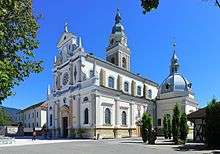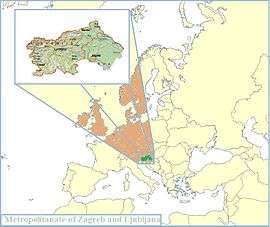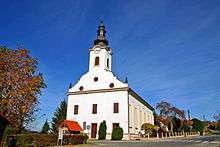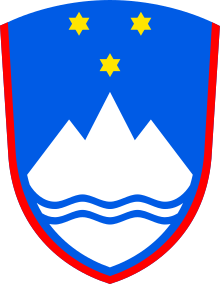Religion in Slovenia
The dominant religion in Slovenia is Christianity, primarily the Catholic Church, the largest Christian denomination in the country. Other Christian groups having significant followings in the country include Eastern Orthodoxy and Protestantism (Lutheranism). Islam, Judaism and Hinduism are small minorities in Slovenia. About 18% of the population are either agnostic or atheist.[2][3]
| Part of a series on |
| Slovenes |
|---|
 |
| Diaspora by country |
|
Argentina · Australia · Austria · Canada · Croatia · Hungary Italy · United States · Venezuela |
| Culture of Slovenia |
|
Literature · Music · Art Cinema · Names · Cuisine Dances · Costume · Sport |
| Religion |
|
Roman Catholicism Protestantism |
| Languages and dialects |
|
Slovene (Prekmurje Slovene · Resian) |
| History of Slovenia |


Religion played a significant role in the development of the Slovenian nation and of the country of Slovenia. After a centuries-long tradition of a state church, interrupted by the periods of Protestant Reformation (in the 16th century) and post–World War II socialism (which ousted religion from the public life), a degree of separation of the state and the church has been reached in independent Slovenia. In February 2007 Slovenia passed a new Religious Freedom Act with a bias towards the Catholic Church (particularly in regard to state funding) and strict terms for the registration of new religious communities.[3]
Religions
Christianity
Catholic Church
The Catholic Church in Slovenia is part of the worldwide Catholic Church, under the spiritual leadership of the Pope in Rome.
There are around 1,135,626 Catholics in the country (about 57.8% of the total population as per the 2002 Census).[2] The country is divided into six dioceses, including two archdioceses. The diocese of Maribor was elevated to an archdiocese by Pope Benedict XVI in 2006. Additionally, the pope created three new sees, namely Novo Mesto, Celje and Murska Sobota.
Protestantism
Protestantism is tightly-knit with the history of Slovenians, with the Slovenian language having been established in the Reformation. Primož Trubar was a leading early Slovenian author and a Protestant reformer. He contributed to the development of the Slovenian language and Slovenian culture.
The Reformation flourished in the 16th century, accounting for the vast majority of cultural development in Slovenian. Lutheranism was the most popular Protestant denomination among Slovenians, with minorities, most notably Calvinism.
Protestantism among Slovenians was aggressively attempted to be wiped out by the Habsburgs with the Counter-Reformation. The Counter-Reformation was heavily deployed to the majority of Slovenian-speaking territory. Means used involved murder, extradition, book-burning and a general ban of the Slovenian language. Excluded were eastern regions (such as Prekmurje), ruled by Hungarian nobility, often Calvinist. Historically, Hungarians had taken up Lutheranism first, before gradually switching to Calvinism. They did not have a policy of extinguishing Lutheranism.
Protestantism among Slovenians survived the Counter-Reformation scattered. Protestantism is a minority group of Christian denominations in the Republic of Slovenia today. The largest community of Protestant Slovenians lives in the Prekmurje region, most of them are Lutheran.[4]
Eastern Orthodoxy
Eastern Orthodoxy maintains a significant presence in the country and is practised in majority by Slovenians of Serbian heritage. Eastern Orthodox Christians in Slovenia are under ecclesiastical jurisdiction of the Serbian Orthodox Metropolitanate of Zagreb and Ljubljana.
Islam
The Muslims in Slovenia are ethnically mostly Bosniaks and other Slavic Muslims.[5] In 2014, there were 48,266 Muslims in Slovenia, making up about 2.4 percent of the total population.[6] The Muslim community of Slovenia is headed by Nedžad Grabus.[7]
According to the published data from the 2002 Slovenian census, out of a total of 47,488 Muslims (2.4% of the total population) 2,804 Muslims (5.90% of the total Muslims in Slovenia) declared themselves as ethnic Slovenian Muslims.[8]
There are also Muslims from Central, South and Southeast Asia, who are not counted in the census because they are migrant workers.
Judaism
The small Jewish community of Slovenia (Slovene: Judovska skupnost Slovenije) is estimated at 400 to 600 members, with the Jewish community of Slovenia suggesting 500 to 1000 members. Around 130 are officially registered,[9] most of whom live in the capital, Ljubljana. The Jewish community was devastated by the Shoah, and has never fully recovered. Until 2003, Ljubljana was the only European capital city without a Jewish place of worship.[10]
Hinduism
220 Hindus live in Slovenia, with 70 belonging to the Hindu Religious Community in Slovenia and 150 belonging to the International Society for Krishna Consciousness (Iskcon).[11]
Demographics
Censuses
Religiosity of Slovene citizens according to population censuses 1991, and 2002.
| Religious group |
Population % 1991[12][13][3] |
Population % 2002[2] |
|---|---|---|
| Christianity | 74.9% | 61.1% |
| Catholicism | 71.6% | 57.8 |
| Lutheran and other Protestants | 0.8% | 0.8% |
| Orthodox Christian | 2.4% | 2.3% |
| Islam | 1.5% | 2.4% |
| Other religion | 0.0% | 0.02% |
| Spiritual but not member of religions | 0.2% | 3.5% |
| Atheists | 4.4% | 10.1% |
| Agnostics | - | 0.0% |
| Unknown | 14.6% | 7.1% |
| Not answered | 0.0% | 15.7% |
Surveys
- Eurobarometer 2012 found about 68% of the population declaring to be Christian, with 64% being members of the Catholic Church. Members of other Christian denominations made up 4% of the population.[14]
- International Social Survey Programme 2015 found that 64.3% of the population declared to be Christian, with Catholicism being the largest denomination accounting for 62.2% of the respondents, and Eastern Orthodoxy being the second-largest sect comprising 1.5%; members of other Christian denominations made up the 0.6%. A further 34.3% declared to have no religion, and 1.5% declared to belong to other religions.[15]
Religious freedom
Slovenia's laws guarantee the freedom of religion and establish a separation between church and state, as well as prohibiting religious discrimination and religious hatred. Religious groups may easily register with the government in order to receive some privileges, largely consisting of various forms of monetary compensation.
Slovenia's laws prohibit circumcision for non-medical reasons and animal slaughtering practices that are necessary for meat to be considered kosher or halal. Members of the Jewish and Muslim communities observe these practices outside of the country (importing meat, and traveling to neighboring countries for religious circumcision) without obstruction from Slovenia's government.[16]
See also
References
- "Eurobarometer 90.4 (December 2018): Attitudes of Europeans towards Biodiversity, Awareness and Perceptions of EU customs, and Perceptions of Antisemitism", Special Eurobarometer, European Union: European Commission, 2019, retrieved 9 August 2019 – via GESIS
- Slovenia Statistical Office. Population by religion, statistical regions, Census 2002.
- Črnič, Aleš; Komel, Mirt; Smrke, Marjan; Šabec, Ksenija; Vovk, Tina (2013). "Religious Pluralisation in Slovenia". Teorija in praksa. University of Ljubljana, Faculty of Sociology, Political Sciences and Journalism. 50 (1): 205–232, 264. ISSN 0040-3598. COBISS 31869277.
- "Zgodovina". Evangeličanska cerkev (in Slovenian).
- Bajt, Veronika (2011). "The Muslim Other in Slovenia. Intersection of a Religious and Ethnic Minority". In Górak-Sosnowska, Katarzyna (ed.). Muslims in Poland and Eastern Europe: Widening the European Discourse on Islam. University of Warsaw Press. p. 307–326. ISBN 9788390322957.
- "Muslim Population by Country: S - T". Ministry of Hajj Kingdom of Saudi Arabia. Retrieved 17 April 2014.
- "Predsednik Mešihata – Mufti Nedžad Grabus" [The President of Meshihat – Mufti Nedžad Grabus] (in Slovenian). Retrieved 9 June 2015.
- "Population by religion and ethnic affiliation, Slovenia, 2002 Census". Statistical Office of the Republic of Slovenia. Retrieved 1 June 2018.
- "Judje zakljuÄ, ujejo praznovanje hanuke". zurnal24.si (in Croatian).
- Jewish Virtual Library - Slovenia
- http://www.dlib.si/details/URN:NBN:SI:DOC-VNL24FNV/?
- "8. Population by religion and type of settlement, Slovenia, Census 1991 and 2002". www.stat.si. Retrieved 2017-12-16.
- Eurel – Sociological and legal data on religions in Europe and beyond. Principal religions and denominations — Slovenia.
- Eurobarometer 393: Discrimination in the EU in 2012 (pdf). European Commission. pp. 233–234. Retrieved 29 December 2015.
- "Country specific religious affiliation or denomination: Slovenia - weighted". International Social Survey Programme: Work Orientations IV - ISSP 2015. 2015 – via GESIS.
- International Religious Freedom Report 2017 Slovenia, US Department of State, Bureau of Democracy, Human Rights, and Labor.

External links
![]()

